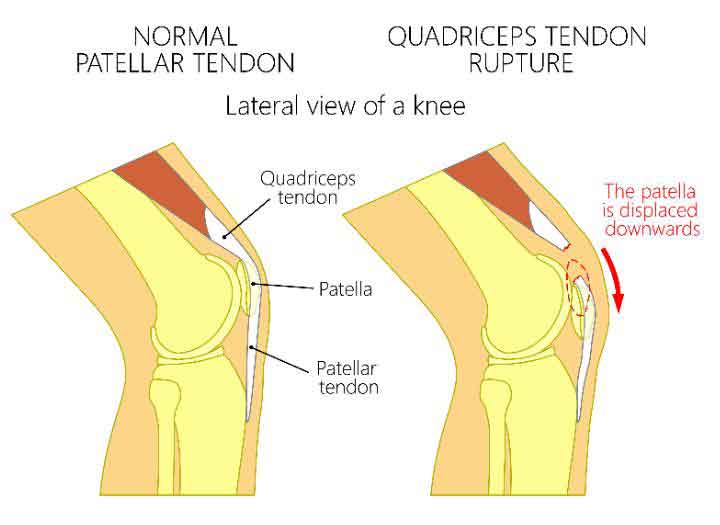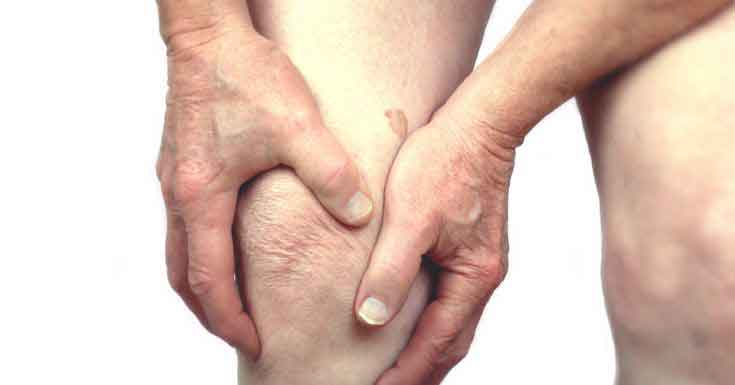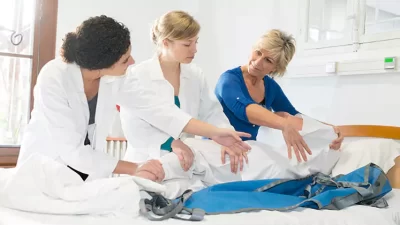Knee pain is one of the most common symptoms in the world, affecting people of various ages and occupations.
Depending on its intensity and frequency, it can have a negative impact on the overall functionality level and, thus, on the quality of life.
It should be mentioned that there are several types of knee pain, in accordance with the actual condition causing such symptoms.
Once the underlying condition is properly diagnosed and treated, knee pain will most likely go away. If the condition is chronic, then treatment is required as well, in order to keep the knee pain under control.
#1 Knee Pain Due To Arthritis
Arthritis is an inflammatory condition, which leads to symptoms such as pain and stiffness. When it comes to the different types of knee pain, the one caused by arthritis stands at the top of the list.
Whether we are talking about osteoarthritis, rheumatoid arthritis or any other form of arthritis, it is important to understand that big joints are almost always affected.
The knee joint is subjected to a lot of physical stress, especially when obesity is a matter to be considered.
People also ask
Q. What vitamins are good for arthritis pain?
A. Nutritional deficiencies are common in arthritis sufferers which are why doctors often recommend their arthritis patient to take dietary supplements containing these nutrients to ease joint pain.. https://www.jointhealthmagazine.com/vitamins-for-arthritis-joint-pain.html
Q. What is Turmeric Curcumin Plus?
A. Turmeric Curcumin Plus is a natural dietary supplement, formulated to aid in boosting joint health and function. Its formulated from Turmeric, which is Super food and it functions well in boosting the general health and wellness of the consumer. https://www.jointhealthmagazine.com/turmeric-plus-review.html
Q. What supplement works best for joint pain?
A. Some consequences of aging – those grey hairs and crow’s feet, for instance – merely change the way we look. As we age on the outside, our joints and ligaments also get older, which often leads to joint pain. And unlike changes to our skin and hair..https://www.jointhealthmagazine.com/jointrelief
Q. How much glucosamine do I need?
A. Arthritis is a very common problem among the Americans. According to the statistics, around 22.7% of the American adults are diagnosed with some forms of arthritis, such as gout, lupus, rheumatoid arthritis, and others..https://www.jointhealthmagazine.com/whats-the-best-glucosamine-dont-take-the-wrong-kind.html
Q. What is the main cause of arthritis?
A. Arthritis is a condition that affects the body’s musculoskeletal system, mainly the joints. It’s reported that this condition is the main reason for disability among people over the age of 55 in the western countries..https://www.jointhealthmagazine.com/causes-of-arthritis.html
Q. What are the side effects of taking Omega XL?
A. Omega XL is a dietary supplement that is designed to help people with painful joints. The products is advertised as a natural supplement that uses handpicked ingredients. According to the producers..https://www.jointhealthmagazine.com/omega-xl.html
Q. Can allergies cause body aches?
A. Rarely do people associate joint pain with allergies. The truth however is that when allergies cause inflammation, joint pains are inevitable. Well, let’s first try to understand what allergies are .The Meaning of Allergies..https://www.jointhealthmagazine.com/how-is-joint-pain-tied-to-allergies.html
Q. What causes pain in the finger joints?
A. Imagine your fingers aching every time you use them. That could be awful. You cannot push a key on your laptop, complete a message on your Android phone, hit those guitar chords, thoroughly and thoroughly clean your body or the plate you used last night..https://www.jointhealthmagazine.com/finger-joint-pain.html
Q. What is in vital 3?
A. Vital 3 is a natural joint supplement that is sold and marketed to promote healthy joint muscles and at the same time to promote joint comfort and improve joint lubrication. As a long term joint care ingredient, this product is touted to work within the first six weeks..https://www.jointhealthmagazine.com/vital-3.html
If you have been diagnosed with arthritis and knee pain is one of your complaints, you will have to consider topical and oral treatments.
It might also be a good idea to try out physical therapy, as this can help you improve your functionality and relieve some of the pain experienced.
Hydrotherapy is also beneficial for such problems, allowing you to increase your range of motion and feel less stiff in the morning.
#2 Knee Pain Due To Tendonitis

Tendonitis is also an inflammatory condition, more often acute than chronic. It appears when the tendons surrounding a joint become inflamed, causing pain and stiffness as well.
The knee pain appears in those who have overused the respective joints, most commonly due to the intense physical exercise (after an extended break).
The tendons become weak due to the lack of exercise and, upon being forced back into action, inflammation will occur as a protective effect.
The knee pain caused by tendonitis can be efficiently treated with anti-inflammatory medication, whether oral or topical. In the situation that the pain becomes too intense, you will most likely be recommended to undergo corticosteroid injections.
These are generally prescribed for chronic tendonitis, providing relief from pain and inflammation. Surgical intervention, physical therapy and a change in lifestyle choices can also be considered.
#3 Knee Pain Due To A Ruptured Tendon
Tendons are highly sensitive to the lack of physical exercise; the longer it has passed since your last training session, the weaker these are going to be.
In the situation that you have taken up a sport after a period of absence, the risk of a tendon rupturing is considerable.
A ruptured tendon causes a number of specific symptoms, starting with intense pain at the level of the knee. Other symptoms include the inability to move the knee joint, inflammation and redness.
The standard treatment for a ruptured tendon is the surgical intervention, followed by immobilization (cast/immobilizer). After the removal of the cast, you will most likely be recommended to undergo physical therapy. The program of exercises will help you strengthen the muscles around the knee joints; moreover, they will be of assistance in increasing the overall range of motion.
Occupational therapy and hydrotherapy are also recommended for this particular type of knee pain.

#4 Knee Pain Due To A Torn Cartilage
The cartilage is one of the most important parts of the knee joints, protecting it against damage and ensuring its necessary lubrication.
A number of factors, including the common wear and tear process, can affect the integrity of the cartilage and increase the risk for rupture. It often happens that the functionality of the knee joint is affected by a torn meniscus, with symptoms such as inflammation, reduced range of motion and pain being part of the clinical picture.
The tear at the level of the meniscus can be partial or total, which also means that the intensity of the knee pain is going to differ.
The most common form of treatment for a torn meniscus is arthroscopic surgery; once the tear in the cartilage has been resolved, the knee pain is going to disappear and the associated symptoms are going to improve as well.
After surgery, it is advisable to undergo physical therapy; this guarantees the best recovery for the operated leg and full functionality for the patient in question.
Read Also – All You Should Know About A Meniscus Injury
#5 Knee Pain Due To Ligament Tear
Knee injuries are common in those who play contact sports, due to the nature of the sport. These injuries can often lead to ligament tears, which in turn will cause pain in the knee joint.
The ACL injury refers to the tearing of the anterior cruciate ligament, which connects the thigh bone to the shin hone.
The most common cause of this ligament tear is a sudden change in direction, as it happens when one plays sports such as basketball or soccer.
The R.I.C.E protocol – rest, ice, compression and elevation – is often recommended as a first care measure for ACL injuries. Physical therapy is the standard measure of treatment; the doctor might also recommend that one wears a brace to keep the knee in a stable position.
Weight bearing will also be forbidden, hence you will need to rely on crutches. Surgical intervention is chosen for more severe ACL injuries and also for those who are professional athletes, requiring a faster recovery.
#6 Knee Pain Due To Fracture
Severe knee pain, associated with the impossibility of moving the respective joint, can be a sign of fracture.
Such fractures are common in those who have been in car accidents, with collision being a causative factor; they are also more common in those who have fallen or in older patients, who suffer from osteoporosis.
A single step is sometimes enough to cause such a fracture, if the bones are no longer strong and the muscles weak as well.
If a fracture has occurred, it is important to establish the type and its extent. The fracture can affect only the kneecap or it can extend to the surrounding bones; moreover, it can be open or closed.
Surgical intervention is a standard method of treatment for such fractures; if the fracture is open, then the intervention is going to be even more complicated.
Following the surgical intervention, the affected leg is going to be placed in a cast. Once the cast is removed, physical therapy will be recommended, in order to restore the functionality of the affected knee joint.
#7 Knee Pain Due To Bursitis

The inflammation of the bursa, which is actually a small sack of fluid that protects the knee joint from damage, can lead to knee pain.
This condition is known as bursitis and it can prevent the knee joint from functioning in a proper manner. If the bursa is inflamed, the tendons and ligaments of the knee will no longer glide smoothly over the respective joint.
Pain and stiffness will appear as natural consequences, requiring immediate treatment and intervention.
The first measure of treatment recommended to those who suffer from bursitis is oral/topical medication (NSAIDs).
In the situation that the inflammation becomes worse, corticosteroid injections will be administered. The R.I.C.E protocol will have to be followed, in order to protect the knee joint from further damage.
If the pain does not back down and the condition seems to progresses, surgical intervention might be recommended (however, this happens quite rarely).
Physical therapy is an excellent form of treatment for bursitis, as it can be used to bring down the inflammation and increase the range of motion in a short period of time.
The physical therapist might also teach the patient what movements have to be avoided in the future, in order to keep the risk of reoccurrence down to a minimum.
See More: The #25 Effective Home Remedies For Knee Pain
Final Word
It is important to understand and remember that there are many more conditions that can lead to the appearance of knee pain.
Among other causes that you should be aware of, there are: cartilage degeneration/injury with loose fragments in the knee joint, iliotibial band syndrome, dislocated patella, hip/foot pain and obesity.
The lack of muscle strength, physical stress due to excess training and previous injuries can also be named responsible. Even gout and pseudogout can cause knee pain, affecting the overall functionality of the patient.
If you are suffering from knee pain, the first thing that you need to do is determine the underlying condition responsible for such symptoms.
Once you have obtained a correct diagnosis, you can go ahead and pursue the best treatment for your own individual situation.
While medication can help you deal with the symptoms, physical therapy can help you restore the functionality of the knee joint and improve your overall quality of life.
The same goes for other forms of treatment, such as occupational therapy, hydrotherapy and taping. Do not hesitate to stay physically active, in order to keep the knee joints safe and sturdy!
Feature Image: Shutterstock.com
In-Post Image: Shutterstock.com & williamsterett.com







 This article changed my life!
This article changed my life! This article was informative.
This article was informative. I have a medical question.
I have a medical question.
 This article contains incorrect information.
This article contains incorrect information. This article doesn’t have the information I’m looking for.
This article doesn’t have the information I’m looking for.